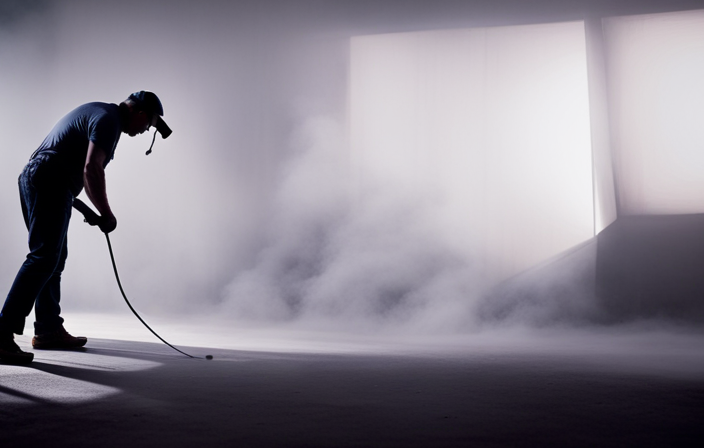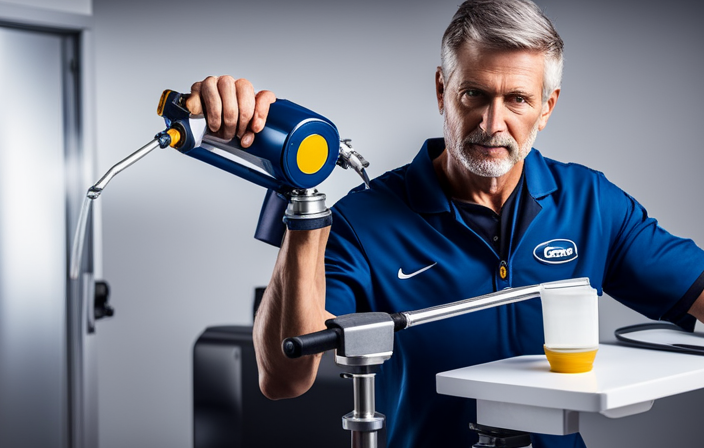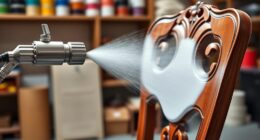Venturing into the world of airless paint sprayers evokes the sentiment, ‘Before me stretches an untouched canvas, awaiting the touch of my brush.’ With each movement, I hold the power to transform an ordinary area into a masterpiece. Yet, embarking on this creative journey necessitates a fundamental understanding of how to operate an airless paint sprayer.
This powerful tool, with its high-pressure system, allows me to achieve smooth and even coverage in a fraction of the time it takes with a brush or roller. In this article, I will guide you through the process of understanding the components, choosing the right paint, familiarizing yourself with the settings, and honing your technique.
We will also explore safety precautions, maintenance, troubleshooting, and proper clean-up and storage. So, let us dive into this world of possibilities and unlock the true potential of the airless paint sprayer.
Key Takeaways
- Check for loose fittings or worn seals before using the sprayer
- Adjust the spray pattern and pressure according to the surface being painted
- Apply paint in light mist coats followed by even, overlapping strokes
- Clean the sprayer thoroughly after use and store it properly to maintain longevity
Understand the Components of an Airless Paint Sprayer
The airless paint sprayer’s components, such as the pump, hose, and nozzle, work in harmony to provide a high-pressure paint application method. This allows for efficient and precise coverage. Understanding these components is essential for proper operation and maintenance of the sprayer.
Sprayer maintenance is crucial to ensure its longevity and optimal performance. Regularly clean the pump filters, check for any clogs or blockages in the hose, and inspect the nozzle for wear and tear.
Troubleshooting tips include checking the power supply, ensuring proper priming, and adjusting the pressure settings. These steps will help resolve common issues and ensure a smooth painting process.
Once you have a good grasp of the sprayer’s components and maintenance, it’s time to move on to the next section: choosing the right paint and preparation.
Choose the Right Paint and Preparation
To ensure optimal results, it’s crucial to select the appropriate type of paint and properly prepare the surface before using an airless paint sprayer.
Paint selection is important because different types of paint have different viscosities and drying times. For example, latex paint is commonly used for interior walls, while oil-based paint is better suited for exterior surfaces.
Additionally, it’s essential to prepare the surface by cleaning it thoroughly, removing any dirt, grease, or loose paint. This can be done using a pressure washer or a scrub brush and detergent.
Sanding the surface may also be necessary to create a smooth and even finish.
By selecting the right paint and preparing the surface adequately, you will be able to achieve professional-looking results with your airless paint sprayer.
Now, let’s move on to familiarizing yourself with the sprayer’s settings and operation.
Familiarize Yourself with the Sprayer’s Settings
Get ready to acquaint yourself with the settings of this magical painting tool, so you can unleash its power and transform your surfaces with a simple flick of a switch. Familiarizing yourself with the sprayer’s settings is crucial for achieving the desired results and avoiding any mishaps along the way.
Here are three key settings you need to know:
-
Pressure Control: Adjusting the pressure determines the spray pattern and coverage. Start with a low pressure setting and gradually increase it until you achieve the desired finish.
-
Tip Size: The size of the spray tip affects the flow rate and the thickness of the paint. Choose the appropriate tip size based on the type of paint and the surface you’re working on.
-
Filter Check: Regular sprayer maintenance is essential for optimal performance. Check and clean the filters regularly to prevent clogging and ensure a smooth flow of paint.
By familiarizing yourself with these settings, you’ll be able to troubleshoot any issues that may arise during your painting project. Now, let’s move on to the next section and learn how to practice proper technique for flawless results.
Practice Proper Technique
Now let’s dive into honing your skills and perfecting the art of using this incredible painting tool by practicing proper technique.
To achieve optimal results with an airless paint sprayer, it’s crucial to maintain a proper stance. Stand with your feet shoulder-width apart, ensuring stability and balance while operating the sprayer. This will allow for better control and precision as you move the sprayer across the surface you’re painting.
Additionally, don’t forget about sprayer maintenance. Regularly clean and inspect the sprayer for any clogs or damage. Proper maintenance will ensure that the sprayer operates smoothly and efficiently, allowing you to focus on achieving a flawless finish.
As we move forward, it’s important to take safety precautions when using an airless paint sprayer, ensuring a secure and hazard-free painting experience.
Take Safety Precautions
When using this powerful tool, it’s crucial to prioritize safety and create a hazard-free painting experience, just like a captain guiding their ship through treacherous waters.
To ensure your safety, always wear the appropriate safety gear, such as goggles, gloves, and a respirator, to protect yourself from potential hazards like paint fumes and overspray.
Additionally, make sure to work in a well-ventilated area or use a ventilation system to minimize inhalation of harmful particles. Keep in mind that airless paint sprayers operate at high pressure, so it’s important to never point the spray gun at yourself or others.
Lastly, be mindful of your surroundings and cover or remove any objects that could be damaged by paint.
With these safety precautions in place, you can confidently move on to the next step of starting your painting project.
Start Painting
Begin the painting process with confidence, as you’ll bring your vision to life with the powerful strokes of your brush.
When using an airless paint sprayer, it’s important to use proper painting techniques to achieve the best results. Start by holding the sprayer at a distance of 12 to 16 inches from the surface, moving your arm in a steady back-and-forth motion. This will ensure an even coat of paint and prevent drips or streaks.
Another important factor to consider is avoiding common painting mistakes, such as overloading the sprayer with too much paint or using excessive pressure. These mistakes can lead to uneven coverage and wasted paint.
Remember to maintain a consistent speed and pressure throughout the painting process. By mastering these techniques and avoiding common mistakes, you’ll achieve professional-looking results.
Transitioning into the next section, let’s now discuss how to properly maintain the sprayer.
Maintain the Sprayer
Maintain the sprayer
Keep your sprayer in top-notch condition by regularly performing maintenance tasks. Proper sprayer maintenance is essential for optimal performance and longevity.
After each use, thoroughly clean the sprayer by flushing it with water or the appropriate cleaning solution. Pay close attention to the nozzle and filters, as they can easily get clogged with paint residue.
Check for any signs of wear or damage on the hoses, seals, and gaskets, and replace them if necessary. Additionally, lubricate the moving parts to ensure smooth operation.
Regularly inspect the sprayer for any leaks or inconsistencies in pressure, and address them promptly. By following these sprayer maintenance tips, you can prevent issues and ensure your sprayer operates at its best.
Transitioning into troubleshooting, let’s now address common problems that may arise during operation.
Troubleshoot Issues
Now that we’ve covered how to maintain your airless paint sprayer, let’s move on to troubleshooting any issues that may arise during operation. It’s important to be aware of common problems that can occur when using an airless paint sprayer and to have some troubleshooting tips in your arsenal.
One common problem is clogging, which can be resolved by cleaning the nozzle or using a filter. Another issue could be uneven spray patterns, which can be fixed by adjusting the pressure or the spray tip. If you experience leaks, check for loose fittings or worn seals.
By addressing these common problems with some simple troubleshooting tips, you can ensure a smooth and efficient painting process. Now, let’s move on to the next section and learn how to finish the job effectively.
Finish the Job
To complete your project successfully, make sure to apply the final coat of paint with precision, leaving behind a flawless and professional finish.
Here are some tips for achieving a smooth finish with an airless paint sprayer. First, make sure the paint is mixed thoroughly and strain it to remove any impurities. Adjust the spray pattern and pressure according to the surface you’re painting. Start with a light mist coat to seal the surface, then follow with even, overlapping strokes.
Avoid overspray by maintaining the correct distance from the surface and using a steady hand. Common mistakes to avoid include spraying too close, applying too thick of a coat, and not allowing sufficient drying time between coats. With these tips in mind, you can achieve a beautiful finish.
Moving on to the next section about clean up and storage, it’s important to properly clean the sprayer after use to maintain its longevity.
Clean Up and Storage
After you’ve finished your project, it’s time to tidy up and find a safe spot to stow away your trusty paint-spraying companion. Cleaning the airless paint sprayer is an essential part of the post-painting process. Start by removing any leftover paint from the sprayer and its components.
Use a cleaning solution recommended by the manufacturer and follow their instructions for a thorough clean. Pay special attention to the nozzle, filters, and hoses to ensure they’re free from any residue.
Once the sprayer is clean, it’s important to store it properly. Make sure to release any pressure, disconnect the power source, and store it in a cool, dry place. It’s also a good idea to protect the sprayer from dust and debris by covering it with a cloth or a plastic bag.
By following these cleaning process and storing tips, you’ll keep your airless paint sprayer in top condition for future projects.
Frequently Asked Questions
How do I choose the right paint for my airless paint sprayer?
To choose the right paint for my airless paint sprayer, I consider compatibility with the sprayer and the project requirements. It’s important to select a paint that is specifically designed for airless spraying to ensure optimal results.
What are the safety precautions I should take while operating an airless paint sprayer?
Paint sprayer safety precautions are crucial to prevent accidents. Always wear proper protective gear, such as goggles, gloves, and a respirator. Maintain a safe distance from the spray, and ensure proper ventilation in the workspace.
Can I use an airless paint sprayer for both interior and exterior painting projects?
Yes, you can absolutely use an airless paint sprayer for both interior and exterior painting projects. It offers the advantage of quick and efficient coverage, making it ideal for large areas and achieving a smooth finish.
How often should I clean and maintain my airless paint sprayer?
I recommend cleaning and maintaining your airless paint sprayer after each use to ensure optimal performance. Some tips for cleaning and maintaining include flushing the system with water or solvent and inspecting and replacing worn or damaged parts.
What are some common issues or troubleshooting tips for using an airless paint sprayer?
Some common issues when using an airless paint sprayer include clogged spray tips, uneven spray patterns, and paint overspray. To troubleshoot, clean the spray tips, adjust the pressure, and practice proper technique to avoid overspray.
Conclusion
In conclusion, operating an airless paint sprayer requires attention to detail and a steady hand. By understanding the components and settings, choosing the right paint, and practicing proper technique, you can achieve a smooth and professional finish.
Remember to take safety precautions and maintain the sprayer for optimal performance. Troubleshoot any issues that may arise and finish the job with confidence. Lastly, clean up and store the sprayer properly to ensure its longevity.
With these tips, you’ll paint like a pro, leaving a trail of vibrant colors in your wake.










